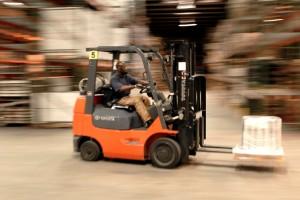What it takes to accelerate supply chain speed and velocity and why it matters.
“I feel the need. The need for speed.” It’s a signature line from the film, “Top Gun,” a brief conversation that takes place between Navy fighter pilots Maverick and Goose before they climb into their planes for a practice dogfight. Of course, the need for speed isn’t just limited to flight maneuvers 30,000 feet up in the sky. Speed, or velocity, is also a must-have for an effective supply chain.

At a recent Supply Chain Management Professionals conference, Greg Rake of Pier 1 Imports noted that the value of an effective supply chain very often comes down to speed – getting products to market faster than your competitors allows you to corner the market, even for a brief time.
Rake also pointed out that time to market is driven by the speed of the supply chain. The faster you can move materials or data from one source to another, the more valuable you are to your customers. The trick is to do so without waste. Every time a product is “touched”, the risk of additional cost, damage or time rises. So, supply chain velocity isn’t about reducing cycle time for speed’s sake. It’s about driving velocity in the service of a larger and more specific business goal.
So, what is a high-speed/velocity supply chain?
In a nutshell, a fast and efficient supply chain:
- Moves fast, but is aligned to a specific purpose or direction
- Is driven by business goals/plans/objectives
- Aims to capture customers in specific markets with specific products
- Flows from robust planning that aligns supply chain activities to business goals
- Offers continuous visibility into supply, demand and product movement
- Features established business processes that ensure destination reliability
Five simple ways to turn up the speed of your supply chain:
- Keep a finger on the pulse of global market conditions and be ready to adapt: Know all you can about everything from macroeconomic issues in Europe to currency fluctuations in China to geopolitical events and the costs of real estate & fuel. This way, you can switch gears to accommodate change in an instant.
- Boost visibility & control: react to customer demand signals fast by improving visibility and control. With access to real-time information on demand/inventory levels, the ability to track product movement from source to shelf and a Control Tower or logistics planning software, you can dynamically plan and adjust product movements to get products into the hands of customers when, where and how they want them.
- Synchronize business processes across functional groups: to make sure the right information gets into the hands of people who need it across every node in your supply chain. This helps align business goals across business processes.
- Harness the power of LEAN to unlock efficiencies in your supply chain: Lean principles drive efficiency by standardizing tasks, processes and the use of technology/materials handling systems. With a Lean culture, you can make better use of time, technology and people, setting performance goals and rewarding employees for exceeding them. You can unlock supply chain efficiencies by creating a Lean culture and a plan to transform and align critical processes and cycle times to your customer and supply chain requirements. However, don’t re-engineer processes just for the sake of change. Make sure all changes align with your overall supply chain strategy.
- Upgrade your supply chain infrastructure to foster collaboration and agility: Make sure your supply chain infrastructure is robust enough to foster collaboration among supply chain partners, support flexible product movements and minimize touches. This might mean using a fast data-exchange platform to get real-time information to every stakeholder, product completion centers to customize packaging before consumption or mixing and consolidation centers to gain economies of scale.
What is your organization doing to increase the speed/velocity of your supply chain to improve customer service and reduce cost and waste?
Written by Michael Rackley, Senior Director of Product Completion, Ryder Supply Chain Solutions
Michael Rackley is Senior Director of Product Completion for Ryder Supply Chain Solutions. In his role, he is responsible for designing plant layouts, engineering specifics, demand planning requirements, shop floor requirements as well as creating awareness for the product completion center solution. Mr. Rackley joined Ryder in 2004 and since then has held various positions of increasing responsibility. Prior to joining Ryder, he worked as the Director of Quality for Lego Systems for 2 years. Before Lego Systems, he worked for Coca Cola USA for 22 years in roles of increasing responsibility and eventually became their Corporate Director of Quality for US Facilities. Mr. Rackley earned a BS in Biology from Lubbock Christian University and an MS in Microbiology from Abilene Christian University. He was also certified as a Logistics Professional with Georgia Tech University.

